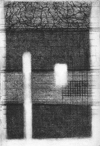manifesto of a (re)searcher
The structures of the brain are the same for every human, but it is the connections within and between these structures that make us independent individuals. These connections called synapses are formed and adjusted by our experiences with the world[1]. The average American spends 95% of their day indoors[2]. The built environment cannot help but influence our experiences and consequently effect who we are.
Our perceptions of self define our entire lives - how we live and work, what we believe, and who we seek relationships with. As our perception of self evolves so do our lives. Throughout this evolution we are experiencing and learning constantly. Architecture remains the backdrop for these experiences. Its power is great because it shapes us whether we are aware of it or not.
1. Self Goal
We seek truth behind our individual existences. Through the process of seeking answers we define ourselves. We define our Self. Our Self is objectively made up of synapses[1]. Subjectively, it is our reason for living. It is the sum of our potential as beings. Seek your Self. Without Self we are purposeless. We cannot be afraid of experiencing the world. Take risks of the heart[3]. Faith gives us balance between the rigors of living day-to-day and the pursuit of Self.
2. Community
Our notion of Self begins with an understanding of humankind as a whole. Societal ideals are characterized in community. Architecture makes community physically and figuratively. The ideas of community help us seek our Self. We must take these general ideas and find our sense of individuality.
3. Be Conscious
Few people are aware of the built environment other than architects[4]. Be conscious of your surroundings. Learning is happening every moment. Learning internalizes what we experience.
4. Balance
Similarities draw us to each other and define us as humans. Recognize the similarities you share with others. We know more about yourselves from knowing people like us. But every person is also unique. There are people out there who are not like you. There are things you have not experienced firsthand. We must celebrate the differences in others and be open minded to indirect knowledge. Recognize the uniqueness of others and of yourself. Maintain balance of Self between your uniqueness and commonalities.
5. Everything in its Place
Within the definition of Self there is a place for the scientific (objective) and a place for the emotional/intuitive (subjective). Both sides should live concurrently. The emotional/intuitive is explained by the scientific. But not vice versa. Decisions and beliefs should not rely on either solely. Question everything. The scientific is not always the answer, but neither is the emotional/intuitive.
6. Full Potential
As humans, self-expression sets us apart from all other animals[1]. It gives us the ability to convey our idea of Self to others. It gives us the ability to achieve great things. Explore the extents of your creative abilities. By not using our assets, we deny the search for Self. So strive to discover your full potential.
7. The Senses
We experience the world through six senses - vision, auditory, olfactory, taste, sensation, and proprioception or “the sense of body awareness”[5]. Each provides input about a situation. The input from the senses are stored in separate neural systems. But when experiences are recalled they are perceived as a cohesive memory and not as separate distinct experiences[1]. A multitude of information about the world can therefore be held in the brain, speaking to an even greater number of experiences. Enjoy life through all your senses. The senses link all of our experiences.
References:
1. LeDoux, J. Synaptic Self: How Our Brains Become Who We Are. New York: Viking, 2002.
2. Makker, K.J., et al. “Critical Statistics.” CRiT: Journal of the AIAS. 54 (Fall 2002): 6.
3. Weaver, M.J. Cloister and Community: Life Within a Carmelite Monastery. Bloomington: Indiana Univ. Press, 2002.
4. Day, C. Places of the Soul: Architecture and Environmental Design As A Healing Art. London: Aquarian, 1993.
5. Carter, R. Mapping the Map. Berkeley, CA: Universityt of California Press, 1998.
